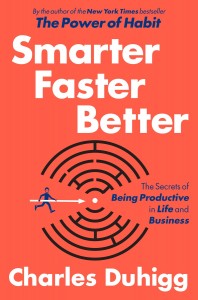
Productivity and the Power of Trust
By The Quiet Leadership Institute
Did you know that in the original version of the movie Frozen, Princess Elsa and Olaf (the snowman sidekick, who loves warm hugs) were both evil? And have you heard of NUMMI, the automobile manufacturing plant that encouraged workers to stop the production line whenever they believed it was necessary? In his new book, Smarter Faster Better, Charles Duhigg, an editor at the New York Times and a Pulitzer-Prize-winning journalist, explores the science of productivity behind these examples and why managing how you think—rather than what you think—can transform your life.
During an interview with QLI, Charles talked about how psychological safety can increase productivity within teams, companies, and, yes, even marriages. Enjoy the highlights below!
QLI: The idea of psychological safety is a theme that runs throughout your book. When have you been in a situation where you felt a sense of psychological safety, either in your professional career or personal life?
Charles Duhigg: One of the things I’ve learned is that the best journalism really comes from teams—a group of people taking on a topic and working together. One of the things I’ve loved most about the Times is that it’s a place that thinks about psychological safety. It thinks about how we create an environment where everyone can speak up. We have this high social sensitivity where we’re actively listening and signaling to each other that we’re listening by saying, “I heard you say this question, and I think it’s a great question—let’s figure out how to explore that,” or “It looks like you don’t like the direction this conversation is going. Tell me what’s going on inside your head.”
Personally, my wife and I try to challenge and encourage each other. If there’s a question I’m dealing with or I need to make a decision, I’ll say, “Here’s exactly what’s going on with me. Here’s the most honest appraisal I can give you of what’s happening.” And it’s her job to say, “I hear what you’re saying, and it sounds like you thought this through. But here are the things I didn’t hear you say. Here are the things I want to challenge you on.” I think that’s the real litmus test of psychological safety—when people feel like they can criticize themselves in front of others and it won’t diminish the opinion everyone else has about them.
I have friends who are co-CEOs of a company. They have a 40-minute drive that they take every day together. They talk about management problems and the challenges they’re dealing with and how they’re going to confront them and what they think the solution is. And it’s really powerful to vocalize what’s going on inside your head to someone who you know is listening to you and to know that it’s a safe enough space that you can test out dumb ideas or mistakes, and analyze them, and they’re not going to hold them against you.
QLI: What are a few things a leader can do, right now, to assess whether employees are making decisions out of fear rather than out of good sense? How can that leader start to turn things around?
CD: For a leader, the number one thing to do is signal the behaviors you hope everyone else models. We know from studies that there are meetings that, when the group norm is for people to be boisterous, even people who think of themselves as being introverts come out of their shells a little more because that is the cultural norm. We also know that people who are extroverts, who have big personalities and are boisterous and gain energy from others, that when they are part of a group that has a norm that is quieter, that they change to that norm.
And the leader has a disproportionate influence on group norms. If you’re the leader of a team and you make a point of never interrupting anyone, your team is actually going to pick up on that norm, maybe without even realizing it. If you’re the member of a team and you want to model a behavior for others, the more you do it and the more deliberately you do it, the more others will start to mirror your behavior. It’s a natural human instinct, and it’s a hugely important social instinct—we learn to interact with each other by looking for cues and modeling how each other behaves. That means this is a tool anyone can use to encourage the behavior they want to see by demonstrating it themselves.
We know some of the best leaders act the way they want those around them to act, which can easily mean not being assertive, not being over the top—but instead being a calming, listening influence because other people will take that cue and they’ll learn from it. It’s a particular challenge if you don’t have space to sit down and say, How do I want my team to behave? How do I demonstrate that behavior? That’s one of the reasons I wrote the book—I wanted to say that here are the choices the most productive people make that you might not even be aware is a choice you may confront. But once you take time to reflect on the fact that you can do things differently—that there is a choice in front of you—that’s when you start becoming genuinely productive instead of being busy.
QLI: What exactly is constructive disturbance, and how can a leader and/or a team find the sweet spot that leads to it?
CD: Leaders who believe in the value of constructive disturbance see the decisions they make as experiments, and they pay attention to what happens after they run the experiment. Most of us don’t tend to look at the choices we’ve made as an experiment—we look at them as something that was good or bad, a success or a failure. But experiments are never binary that way—experiments are things that give us both success and failure. Usually what a scientist does is try to figure out the ratio: “This experiment was 90% a failure and 10% a success because I learned X and I can use X to run the experiment again a little bit better.” That’s a powerful framework for thinking about the decisions we’ve made. We know that every choice has good elements and bad elements. Understanding how to quantify that, how to recognize the good and the bad, that’s how you learn what to replicate and what to discard.
When people bring some disturbance into their life, the next essential step is to take a step back a little bit later and say, “Okay, so I ran an experiment. What did I learn that worked, and what did I learn that didn’t work? How do I take that knowledge and build on it for the next experiment I’m going to run?” When something doesn’t work, it’s not a failure. It’s an experiment that gave you some data. The only way it ever becomes a failure is if you don’t learn what you can from it, if you don’t make it useful.

Charles Duhigg has worked at the New York Times since 2006. His series “The iEconomy,” which focused on Apple, won a Pulitzer Prize for explanatory reporting in 2013. Other series Charles contributed to include “Golden Opportunities,” “The Reckoning,” and “Toxic Waters.” He is also the author of The Power of Habit—a book about the science of habit formation in our lives, companies, and societies.
If you would like to read additional interview highlights, including how leaders can encourage a psychologically safe team environment for introverts, be sure to sign up for the QLI newsletter.







